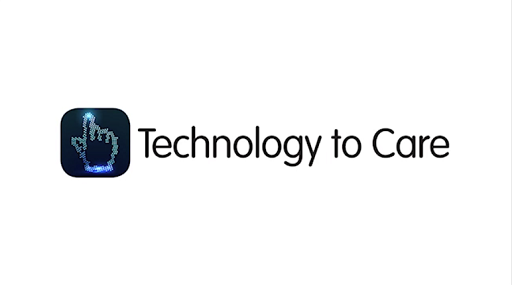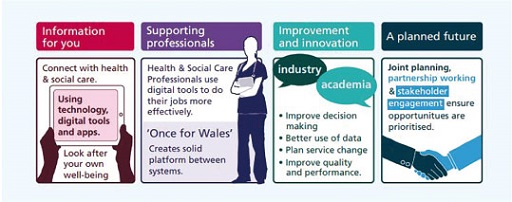4 Technology-enhanced care in Wales
The Welsh Government outlined an intention to use technology to enhance care in Wales in 2015 in its report, ‘Informed Health and Care: A digital health and social care strategy for Wales’. Figure 1 shows the ways in which digital technology is expected to transform care.
Some of the unique challenges for Wales include incorporating the use of the Welsh language in any IT or digital technologies and ensuring the languages are treated with equal parity. This means that if a particular service or app was to be offered to service users, there would have to be some consideration that some Welsh people can only or would prefer to receive this in Welsh (Welsh Government, 2015). Overall, in Wales there is the expectation that technology will enhance care by allowing service users to:
- see their own data and information to make better decisions about their care
- add information to their data and records (such as linking to their apps and wearable devices)
- access and use digital apps and wearable devices
- use the internet to connect to social care services and communicate with professionals via video conferencing, email and text
- use digitally-enabled services to support them to be able to live independently as long as possible.
For example, Powys, a region in Wales which is one of six locations in Europe that is taking part in a project on technology-enhanced care for older people who have chronic conditions. One hundred people in Powys are included in the project, CareWell. As part of the project, participants’ electronic data and records will be shared between community workers equipped with mobile devices and there will also be a shared record between GPs and hospital doctors. This project is about supporting the service user to remain safely and independently in their own home through all the health and social care professionals who are supporting the service user to all work from and input into the same electronic ‘patient record’ so that care is joined up. As part of the project, the community worker will also be able to communicate using the mobile device with the service user’s informal caregiver using text and picture messaging (Welsh Government, 2015; CareWell, n.d.). The CareWell project is a way to determine how and whether technology-enhanced care actually does work in practice and how it works.
In the next activity, you will learn about the some of the practical issues around incorporating technology into care in Wales.
Activity 3 Changing practice through technology in Wales
Watch the following video, concentrating particularly on the section from 2 minutes 39 seconds onwards, about incorporating technology into social care. The speakers include a social care professional from Wales, England, Scotland and Northern Ireland. They are all discussing both the opportunities and the challenges that this strategy will present for social care in incorporating assistive technologies in relation to their social care workforce in their own national setting. As you watch the video, make a list of all the advantages/opportunities that the speakers mention in the video in the left-hand column below, and all the disadvantages/challenges that are mentioned in the right-hand column below.

Transcript: Video 1
| Advantages and opportunities for technology-enhanced care | Disadvantages and challenges for technology-enhanced care |
|---|---|
Discussion
Here is an example completed table:
| Advantages and opportunities for technology-enhanced care | Disadvantages and challenges for technology-enhanced care |
|---|---|
| People want to see the strategy succeed | Trying to meet needs with less resources |
| Relying less on paper and paperwork | Some people don’t have good access to technologies |
| Support staff can scaffold learning of service users to use internet and technology themselves (as they see it in action) | Need to build in digital skills or literacy into how social care employers recruit, induct and train |
| The staff themselves will learn and gain confidence using technology | Some managers/employers feel that they need more qualification or training in technologies themselves in order to manage their teams |
| People using the equipment gain digital confidence – staff and service users | There might not be many relevant training and qualifications to support technology in care in the early stages of adoption |
| Can reduce social isolation | |
| Relieves pressures on carers | |
| Reduces lack of access to technology | |
| Particularly useful for people who live in remote or rural areas | |
| Can be used to improve quality of life and independence for people, enabling them to stay at home for longer | |
| It’s exciting and innovative to include technology |

